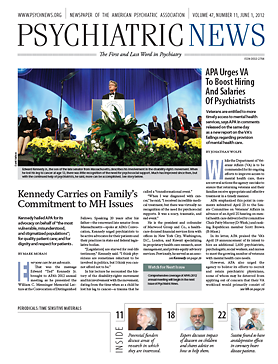How has the public perception of mental illness changed over time? And how does that perception affect the lives of individuals living with these disorders?
These questions are at the center of two new studies—one evaluating first-year results of a high-profile British anti-stigma program and the other assessing how the ability to recognize mental illness and understand approaches to treatment has evolved over nearly two decades in Australia.
Stigma Appears to Ebb in Britain
The British study, published in the May Psychiatric Services, considers discrimination from the viewpoint of those directly experiencing it.
Claire Henderson, M.D., Ph.D., of the Department of Health Service and Population Research at King’s College London led a team comprising departmental colleagues and researchers affiliated with the London-based nongovernmental organization Rethink Mental Illness in assessing the amount and types of discrimination reported by adults with mental illness before and after introduction of England’s Time to Change (TTC) program.
Launched in January 2009 with $33 million in funding from the Big Lottery Fund and Comic Relief, TTC is focused on achieving a 5 percent reduction in mental-health-related discrimination through such initiatives as an anti-stigma educational campaign, community activities designed to bring together people with and without mental illness, and a Web-based resource on mental illness in the workplace. Both Rethink Mental Illness and the British mental health charity Mind provide programmatic support for TTC.
For the study, the researchers compared the results of telephone interviews conducted with 537 participants in 2008 and 1,047 individuals in 2009, all of whom were aged 18 to 65, non-institutionalized, and registered as users of mental health services with Britain’s National Health Service. Interviewers used the nationally standardized 22-item Discrimination and Stigma Scale to assess the level of discrimination experienced by participants across a range of life areas.
The survey findings showed that 87 percent of respondents said they experienced more than one instance of discrimination in 2009. While a staggering percentage, this was down from 91 percent of participants in 2008. This drop reflected a significant reduction in discrimination from several sources, including family (from 53 percent in 2008 to 46 percent in 2009) and friends (from 53 percent to 39 percent).
Respondents also reported significant decreases in mental illness discrimination associated with dating (from 31 percent in 2008 to 18 percent in 2009) and finding a job (from 24 percent to 16 percent).
However, the proportion of respondents reporting discrimination from mental health professionals dropped only 2 percent. This finding, according to the researchers, may indicate a need for anti-stigma efforts targeted at specific audiences rather than merely the public at large.
Public Recognition on Rise Down Under
The Australian study, published in May’s British Journal of Psychiatry, also found modest gains in the public’s understanding of mental illness.
Nicola Reavley, Ph.D., and Anthony Jorm, Ph.D., D.Sc., of the University of Melbourne’s Orygen Youth Health Research Centre compared results of a 2011 national survey of 6,019 adults with findings from surveys conducted in 1995 (2,164 adults) and 2003/2004 (3,998 adults).
While the most recent survey was conducted by phone, as opposed to the two earlier in-person surveys, the questions included in all three were similar. Randomly selected respondents were asked to identify the disorder described in vignettes about individuals with depression or schizophrenia, as well as the best course of action for addressing the disorder and the likelihood of recovery or remission.
Survey participants were also questioned about the perceived benefit of various treatment options, including seeing a physician or mental health professional, taking prescription medications or over-the-counter remedies, consulting with clergy, reaching out to friends or family, and exercising.
The researchers observed a marked improvement in the recognition of depression, rising from just 39 percent of participants in 1995 to 67.3 percent in 2003/2004 and 73.9 percent in 2011.
This growth in public understanding could be partly attributable to Australia’s “beyondblue” national depression initiative, the researchers suggested.
And while the percentage of respondents identifying psychiatrists, medication, or counseling as the best treatment option for depression dropped significantly from 1995 to 2011, the 16-year time span saw significant growth in beliefs about the helpfulness of these same interventions. In particular, more than twice as many respondents rated antidepressants as being helpful in 2011 than in 1995 (59 percent vs. 28.7 percent).
The public’s recognition of schizophrenia was more variable throughout the three study periods, rising from 26.8 percent in 1995 to 42.5 percent in 2003/2004 before dropping slightly to 37.9 percent in 2011. However, the percentage of respondents citing the helpfulness of antipsychotics more than doubled between 1995 and 2011, rising from 23.2 percent to 48.3 percent.
For both disorders, the researchers also noted a significant decrease in the percentage of respondents stating that they believe a full recovery from the disorders is likely, with a corresponding increase in support of a likely full or partial recovery with relapses.


